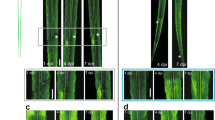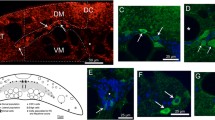Summary
In crayfish, the severed distal segment of single lateral giant axon (SLGA) often survives for at least 10 months after lesioning if this segment retains a septal region of apposition with an adjacent, intact SLGA. In control (unsevered) SLGAs, this septal region usually contains gap junctions and 50–60 nm vesicles near the axolemma of both SLGAs. From 1–14 days after lesioning, the distal segment of a severed SLGA undergoes obvious ultrastructural changes in mitochondria and neurotubular organization compared to control SLGAs or to adjacent, intact SLGAs in the same animal. Gap junctions are very difficult to locate in severed SLGAs within 24 h after lesioning. From two weeks to ten months after lesioning, the surviving stumps of severed SLGAs often appear remarkably normal except that structures normally associated with the presence of gap junctions remain very difficult to find.
These and other data suggest that SLGA distal segments receive trophic support from adjacent, intact SLGAs. The mechanism of this support probably could not be via diffusion across gap junctions between intact and severed SLGAs since gap junctions largely disappear after lesioning. However, trophic maintenance could occur via the exocytotic — pinocytotic action of 50–60 nm vesicles which are always present on both sides of the septum between an intact SLGA and a severed SLGA distal segment.
Similar content being viewed by others
References
Anderson TE, Bittner GD (1980) Long term alteration of electrotonic synapses. Brain Res 184:13–36
Asada V, Bennett MVL (1971) Experimental alteration of coupling resistance at an electrotonic synapse. J Cell Biol 49:159–171
Bennett MVL (1973a) Function of electrotonic junctions in embryonic and adult tissues. Fed Proc 32:65–75
Bennett MVL (1973b) Permeability and structure of electrotonic junctions and intercellular movements of tracers. In: Kater SD, Nicholson C (ed) Intracellular staining techniques in neurobiology. Elsevier, Amsterdam London New York, pp 115–133
Bennett MVL, Goodenough DA (1978) Gap Junctions. Neurosci Res Prog Bull 16:373–485
Bittner GD (1977) Trophic interactions of crustacean neurons. In: Hoyle G (ed) Identified Neurons and Behavior, Plenum Press, New York, pp 507–532
Bittner GD, Johnson A (1974) Degeneration and regeneration in crustacean peripheral nerves. J Comp Physiol 89:123–144
Bittner GD, Mann DW (1976) Differential survival of isolated portions of crayfish axons. Cell Tissue Res 169:301–311
Bittner GD, Nitzberg M (1975) Degeneration of sensory and motor axons in transplanted segments of a crustacean peripheral nerve. J Neurocytol 4:7–21
Bittner GD, Ballinger M, Larimer JL (1974) Crayfish CNS: minimal degenerative-regenerative changes after lesioning. J Exp Zool 189:13–36
Broadwell RD, Brightman MW (1979) Cytochemistry of undamaged neurons in transporting exogenous protein in vivo. J Comp Neurol 185:31–74
Hama K (1961) Some observations on the fine structure of the giant fibers of the crayfishes (Cambarus virilis and Cambarus clarkii) with special references to the submicroscopic organization of the synapses. Anat Rec 141:275–293
Johnson GE (1924) Giant nerve fibers in crustaceans with special reference to Cambarus and Palaemonetes. J Comp Neurol 36:323–373
Kuhnt U, Kelly MJ, Schaumberg R (1979) Transynaptic transport of procion yellow in the central nervous system. Exp Brain Res 35:371–385
Lasek RJ, Dabrowski C, Nordlander R (1973) Analysis of axoplasmic RNA from invertebrate giant axons. Nature 224:163–165
Lasek RJ, Gainer H, Przybylski RJ (1974) Transfer of newly synthesized proteins from Schwann cells to the squid giant axon. Proc Natl Acad Sci USA 71:1188–1192
Lasek RJ, Gainer H, Barker JL (1977) Cell to-cell transfer of glial proteins to the squid giant axon. J Cell Biol 74:501–523
Lowenstein WR (1975) Permeable junctions. CSH Symp Quant Biol 40:49–63
Meyer MR (1973) Unidirectional slow transport in axons of crayfish ventral nerve cord. Am Zool 13:216A
Meyer MR, Bittner GD (1978a) Histological studies of trophic interactions in crayfish giant axons. Brain Res 143:195–211
Meyer MR, Bittner GD (1978b) Biochemical studies of trophic interactions in crayfish giant axons. Brain Res 143:212–232
Nordlander RH, Masnyi JA, Singer M (1975) Distribution of ultrastructural tracers in crustacean axons. J Comp Neurol 161:499–574
Nordlander RH, Singer M (1972) Electron microscopy of severed motor fibers in the crayfish. Z Zellforsch 126:157–181
Pappas GD, Asada Y, Bennett MVC (1971) Morphological correlates of increased coupling resistance at an electrotonic synapse. J Cell Biol 49:173–188
Peracchia C (1973) Low resistance junctions in crayfish. I. Two arrays of globules in junctional membranes. J Cell Biol 53:54–65
Peracchia C (1974) Excitable membrane ultrastructure. I. Freeze fracture of crayfish axons. J Cell Biol 61:107–122
Peracchia C, Mittler RS (1972) Fixation by means of glutaraldehyde-hydrogen peroxide reaction products. J Cell Biol 53:234–238
Politoff AC (1977) Protein semiconduction: An alternative explanation of electrical coupling. In DeMello WC (ed) Intercellular communication. Plenum Press, New York, pp 127–144
Robertson JD (1953) Ultrastructure of two invertebrate synapses. Soc Exp Biol Med 82:219–223
Schmitt FO, Der P, Smith BH (1976) Electrotonic processing of information by brain cells. Science 193:114–120
Singer M, Salpeter MM (1966) The transport of 3H-1-Histidine through the schwann and myelin sheath into the axon of peripheral nerves. J Morphol 120:281–316
Spurr AR (1969) A low viscosity epoxy resin embedding medium for electron microscopy. J Ultrastruct Res 26:31–43
Zampigi F, Ramon F, Duran W (1978) Fine structure of the electrotonic synapse of the lateral giant axons in a crayfish (Procambarus clarkii). Tissue Cell 10:413–426
Author information
Authors and Affiliations
Additional information
This work was supported by NIH research grant NS-14412 and and RCDA 00070 to G.D.B.
Rights and permissions
About this article
Cite this article
Bittner, G.D., Ballinger, M.L. Ultrastructural changes at gap junctions between lesioned crayfish axons. Cell Tissue Res. 207, 143–153 (1980). https://doi.org/10.1007/BF00239336
Accepted:
Issue Date:
DOI: https://doi.org/10.1007/BF00239336




